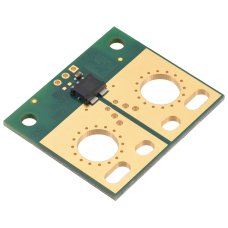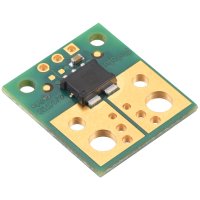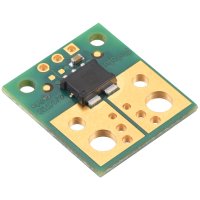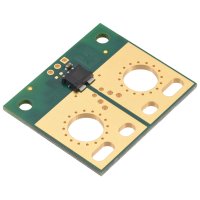This is the large version of a simple carrier for Allegro’s ACS72981ELRATR-200B5 Hall effect-based, electrically isolated current sensor, which offers a low-resistance (~0.2 mΩ) current path and a high 250 kHz bandwidth for fast response times.
Overview:
We are offering these breakout boards with support from Allegro Microsystems as an easy way to use or evaluate their ACS72981xLR Hall effect-based, electrically isolated current sensors; we therefore recommend careful reading of the ACS72981 datasheet before using this product. The following list details some of the sensor’s key features:

- Hall effect-based sensor with electrically isolated current path allows the sensor to be inserted anywhere along the current path and to be used in applications that require electrical isolation.
- Differential Hall sensing rejects common-mode fields, so the orientation of the sensor relative to uniform external magnetic fields (e.g. the Earth’s magnetic field) has less effect on the measurement.
- The conductive path internal resistance is typically 0.2 mΩ, and the PCB is made with 6 layers of 2-oz copper, so very little power is lost in the module.
- High-bandwidth 250 kHz analog output voltage proportional to AC or DC currents
- Less than 2 µs response time.
- Integrated digital temperature compensation circuitry allows improved accuracy over the full operating temperature range.
- Carrier boards, available in compact and large sizes, offer a variety of ways to insert it into the current path along with 0.1″-pitch (breadboard-compatible) power, ground, and output pins.
- 3.3V and 5V versions available.
- Unidirectional and bidirectional versions available.

The connection points are labeled on the bottom silkscreen. The silkscreen also shows the direction that is interpreted as positive current flow via the +i arrow.
Details for item #5282:


This large carrier features the ACS72981ELRATR-200B5, which is intended for nominal 5 V operation and is designed for bidirectional input current from -200 A to +200 A. This version can be visually distinguished from the other versions by the “5V B20” printed on the bottom side, as shown in the left picture above.
Part Suffix Range Supply Voltage Sensitivity @ 5 V Zero Point @ 5 V Size
200B5 ±200 A (bidirectional) 4.5 V to 5.5 V 10 mV/A 2.5 V 1.4″×1.2″
A compact carrier is also available for this sensor IC for more space-constrained applications or to evaluate the IC’s performance with a smaller PCB area for thermal dissipation.
Using the sensor

This sensor has five required connections: the input current (IP+ and IP-), logic power (VCC and GND), and the sensor output (VIOUT).
The sensor requires a supply voltage of 4.5 V to 5.5 V to be connected across the VCC and GND pads, which are labeled on the bottom silkscreen. The sensor outputs a ratiometric analog voltage on VIOUT that is centered at VCC/2 and changes by 10 mV × (VCC/5 V) per amp of input current, with positive current increasing the output voltage and negative current decreasing the output voltage:
VIOUT=VCC/2+0.01V/A⋅VCC/5V⋅IP=VCC⋅(1/2+IP/500A)
IP=500A⋅(VIOUT/VCC–1/2)
The VIOUT, VCC, and GND pins work with 0.1″-pitch header pins and are compatible with standard solderless breadboards.

You can insert the board into your current path in a variety of ways. The largest through-holes are 8.4 mm in diameter with 20 mm spacing. These can be used with 5/16″ or M8 screws for attaching various types of lugs or solderless ring terminals, or thick wires up to 2 AWG can be soldered directly to the board. The slots near the edge of the board can accommodate a 4-pin terminal block or other connector with a pitch between 7.5 mm and 9.5 mm. Examples of these kinds of connections are shown in the pictures below. Holes with 0.1″, 3.5 mm, and 5 mm spacing are also available for connecting male header pins or terminal blocks, but please note that these smaller connection options are generally not suitable for high currents like those this sensor is intended for.






Warning: This product is intended for use below 30 V. Working with higher voltages can be extremely dangerous and should only be attempted by qualified individuals with appropriate equipment and experience.
Schematic and dimension diagrams:

The dimension diagram is available as a downloadable PDF (400k pdf).
Real-world power dissipation considerations

Depending on the version, the ACS72981 can measure up to ±200 A, but its datasheet specifies an absolute maximum continuous current of 120 A. Furthermore, the sensor chip can overheat at lower currents. In our tests, we found that our ACS72981 carrier boards could conduct 60 A continuously while staying well below the thermal limit for the IC. Our tests were conducted at approximately 25°C ambient temperature with no forced air flow.
The actual current you can pass through the sensor will depend on how well you can keep it cool. The carrier’s printed circuit board is designed to help with this by drawing heat out of the sensor chip. Solid connections to the current path pins (such as with thick soldered wires or large, tightly-secured lugs) can also help reduce heat build-up in the sensor and carrier board.
Warning: Exceeding temperature or current limits can cause permanent damage to the sensor. If you are measuring an average continuous current greater than 50 A, we strongly recommend that you monitor the sensor’s temperature and look into additional cooling if necessary.
This product can get hot enough to burn you long before the chip overheats. Take care when handling this product and other components connected to it.
Package Includes:
- 1 x Pololu 5282 ACS72981ELRATR-200B5 Current Sensor Large Carrier -200A to +200A, 5V
Pololu 5282 ACS72981ELRATR-200B5 Current Sensor Large Carrier -200A to +200A, 5V
- Brand: Pololu
- Product Code: NR-Pololu-5282-Current-Sensor
- Reward Points: 12
- Availability: In Stock
- रo 1,181.00
-
रo 1,134.00
- Price in reward points: 1181
-
- 12 or more रo 1,172.00
- 25 or more रo 1,120.00
- 96 or more रo 1,070.00
Related Products
Pololu 5250 / 5251 ACS72981LLRATR-050B3 / 050B5 Current Sensor Compact Carrier -50A to +50A, 3.3V / 5V
This is the compact version of a simple carrier for Allegro’s ACS72981LLRATR-050B3/B5 Hall effect-ba..
रo 906.00 रo 944.00
Pololu 5255 / 5256 ACS72981LLRATR-100U3/U5 Current Sensor Compact Carrier 0A to 100A, 3.3V/5V
This is the compact version of a simple carrier for Allegro’s ACS72981LLRATR-100U3/U5 Hall effect-ba..
रo 906.00 रo 944.00
Pololu 5270 / 5271 ACS72981LLRATR-050B3/050B5 Current Sensor Large Carrier -50A to +50A, 3.3V / 5V
This is the large version of a simple carrier for Allegro’s ACS72981LLRATR-050B3 / 050B5 ..
रo 1,134.00 रo 1,181.00
Pololu 5272 ACS72981LLRATR-050U3 Current Sensor Large Carrier 0A to 50A, 3.3V
This is the large version of a simple carrier for Allegro’s ACS72981LLRATR-050U3 Hall effect-based, ..
रo 1,134.00 रo 1,181.00
Pololu 5273 / 5274 ACS72981LLRATR-100B3/100B5 Current Sensor Large Carrier -100A to +100A, 3.3V / 5V
This is the large version of a simple carrier for Allegro’s ACS72981LLRATR-100B3/100B5 Hall eff..
रo 1,134.00 रo 1,181.00





